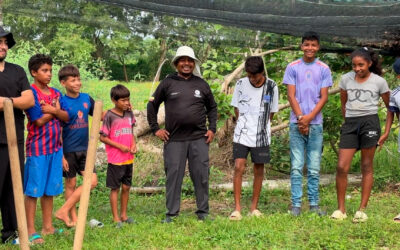 “What most impressed me was that wall. The true poverty is on the other side of it. The true wealth is on this side, for love is the true wealth, the ability to give and to share. On that side of the wall, there is self-interest and competition. . . .” Focolare president, Maria Voce, spoke these words before leaving the island of St Terezinha, Brazil. Focolare co-president, Giancarlo Faletti added: “Today we were at school. You were our teachers. It was a gift from God. Thank you!”
“What most impressed me was that wall. The true poverty is on the other side of it. The true wealth is on this side, for love is the true wealth, the ability to give and to share. On that side of the wall, there is self-interest and competition. . . .” Focolare president, Maria Voce, spoke these words before leaving the island of St Terezinha, Brazil. Focolare co-president, Giancarlo Faletti added: “Today we were at school. You were our teachers. It was a gift from God. Thank you!”
The wall of which Maria Voce speaks was constructed to interrupt the view of the poverty stricken quarter so near. But the poverty is still there and the wall remains a sign of the social segregation.
What are the signs of wealth that Maria Voce refers to? “This place had been called Hell Island because of the poverty and degradation of the people living here. The Gospel message that the people of the Focolare have been living and sharing with us for fifty years, supporting us, has freed us within,” says Johnson, who was our guide through the area. “It has opened new horizons for us, changing us into protagonists in the transformation of the quarter and our social standing.

Gradually a community with a deep civic awareness formed. An association of islanders was established as they took responsibility for their development. The country’s democratic openness made new systems of participation possible with the city, as well as public financial resources. There were many achievements: electricity for the area, paved roads, a school and health centre staffed by teachers and medical workers from the Movement. Several times Johnson proudly repeated: “We obtained it all through the power of dialogue, with the power of the community, without seeing a single politician.”
The final stop on the visit was to the Centre for Children and Teenagers that is open after school hours, providing a safe haven from violence and drugs on the streets. Here they are offered a solid human and spiritual experience, through a variety of sport and musical activities. The centre is administrated by the AACA, an association supported by many, Brazilian Focolare families and families around the world. The guests were welcomed with a song from the little ones: “Oh, my God, I know life should be better than this, and it will, but this doesn’t stop us from singing: it’s beautiful, beautiful, beautiful!”
“This is a place in which you can see the good fruits that are produced by the seed of the Gospel,” Maria Voce said to the workers at the centre. “When we leave we will not only be bringing all of you with us in our hearts, but also your example that is an incentive for the entire Movement all over the world.”
Follow the journey on the Mariapolis Journal- login required
Website: www.focolares.org.br/sitenacional




0 Comments